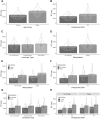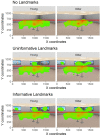Age-related changes in visual encoding strategy preferences during a spatial memory task
- PMID: 33755797
- PMCID: PMC8885492
- DOI: 10.1007/s00426-021-01495-5
Age-related changes in visual encoding strategy preferences during a spatial memory task
Abstract
Ageing is associated with declines in spatial memory, however, the source of these deficits remains unclear. Here we used eye-tracking to investigate age-related differences in spatial encoding strategies and the cognitive processes underlying the age-related deficits in spatial memory tasks. To do so we asked young and older participants to encode the locations of objects in a virtual room shown as a picture on a computer screen. The availability and utility of room-based landmarks were manipulated by removing landmarks, presenting identical landmarks rendering them uninformative, or by presenting unique landmarks that could be used to encode object locations. In the test phase, participants viewed a second picture of the same room taken from the same (0°) or a different perspective (30°) and judged whether the objects occupied the same or different locations in the room. We found that the introduction of a perspective shift and swapping of objects between encoding and testing impaired performance in both age groups. Furthermore, our results revealed that although older adults performed the task as well as younger participants, they relied on different visual encoding strategies to solve the task. Specifically, gaze analysis revealed that older adults showed a greater preference towards a more categorical encoding strategy in which they formed relationships between objects and landmarks.
© 2021. The Author(s).
Conflict of interest statement
The authors declare that the research was conducted in the absence of any commercial or financial relationships that could be construed as a potential conflict of interest.
Figures






Similar articles
-
Age-related differences in visual encoding and response strategies contribute to spatial memory deficits.Mem Cognit. 2021 Feb;49(2):249-264. doi: 10.3758/s13421-020-01089-3. Mem Cognit. 2021. PMID: 32869141 Free PMC article.
-
The contribution of visual attention and declining verbal memory abilities to age-related route learning deficits.Cognition. 2019 Jun;187:50-61. doi: 10.1016/j.cognition.2019.02.012. Epub 2019 Feb 28. Cognition. 2019. PMID: 30826535
-
Familiar environments enhance object and spatial memory in both younger and older adults.Exp Brain Res. 2016 Jun;234(6):1555-74. doi: 10.1007/s00221-016-4557-0. Epub 2016 Jan 28. Exp Brain Res. 2016. PMID: 26821318
-
Differences in Encoding Strategy as a Potential Explanation for Age-Related Decline in Place Recognition Ability.Front Psychol. 2020 Sep 10;11:2182. doi: 10.3389/fpsyg.2020.02182. eCollection 2020. Front Psychol. 2020. PMID: 33013562 Free PMC article.
-
Does visual working memory represent the predicted locations of future target objects? An event-related brain potential study.Brain Res. 2015 Nov 11;1626:258-66. doi: 10.1016/j.brainres.2014.10.011. Epub 2014 Oct 17. Brain Res. 2015. PMID: 25445999 Review.
Cited by
-
Perspective taking and systematic biases in object location memory.Atten Percept Psychophys. 2021 Jul;83(5):2033-2051. doi: 10.3758/s13414-021-02243-y. Epub 2021 Mar 15. Atten Percept Psychophys. 2021. PMID: 33723725 Free PMC article.
-
The role of memory and perspective shifts in systematic biases during object location estimation.Atten Percept Psychophys. 2022 May;84(4):1208-1219. doi: 10.3758/s13414-022-02445-y. Epub 2022 Feb 16. Atten Percept Psychophys. 2022. PMID: 35174468 Free PMC article.
-
Comparable performance on a spatial memory task in data collected in the lab and online.PLoS One. 2021 Nov 29;16(11):e0259367. doi: 10.1371/journal.pone.0259367. eCollection 2021. PLoS One. 2021. PMID: 34843521 Free PMC article.
-
Getting LOST: A conceptual framework for supporting and enhancing spatial navigation in aging.Wiley Interdiscip Rev Cogn Sci. 2024 Mar-Apr;15(2):e1669. doi: 10.1002/wcs.1669. Epub 2023 Nov 7. Wiley Interdiscip Rev Cogn Sci. 2024. PMID: 37933623 Free PMC article. Review.
-
Less spatial exploration is associated with poorer spatial memory in midlife adults.Front Aging Neurosci. 2024 Jun 11;16:1382801. doi: 10.3389/fnagi.2024.1382801. eCollection 2024. Front Aging Neurosci. 2024. PMID: 38919601 Free PMC article.
References
-
- Baayen RH, Davidson DJ, Bates DM. Mixed-effects modeling with crossed random effects for subjects and items. Journal of Memory and Language. 2008;59(4):390–412. doi: 10.1016/j.jml.2007.12.005. - DOI
-
- Braver, T. S., & West, R. (2008). Working memory, executive control, and aging. In F. I. M. Craik and T. A. Salthouse (Eds.), The handbook of aging and cognition (p. 311–372). Psychology Press
MeSH terms
LinkOut - more resources
Full Text Sources
Other Literature Sources
Medical

